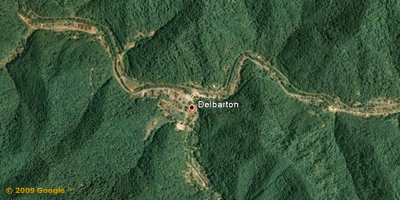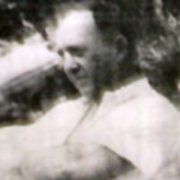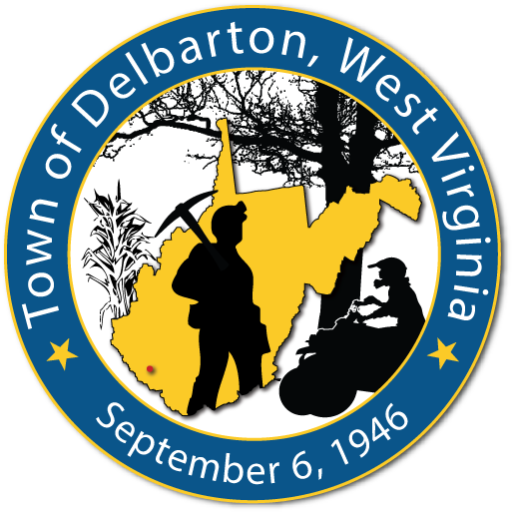Nestled in the heart of the Appalachians, The Town of Delbarton, Past, present, and future, has undergone many transformations throughout the years and while some of the things have changed; some have remained the same in our hometown.

Aerial Image of Delbarton, WV
Years ago, explorers, settlers, and hunters came to what is now called Delbarton, and camped under a big rock overhang on the east side of Pigeon Creek, just above its junction with Rock House Creek.
Upon each trip to this area, the hunters would plan to come to this same rock to camp and use it as a shelter. They cut small trees and built a pin around the outside and enclosed the cave-like hole in the hill and used this as a house.
The hunters referred to this place as the rock house, thus it became known as the Rock House Fork of Pigeon Creek. Then as people begin to settle in the area, they began to call it Rock House. When the first post office was opened here it needed a name, but there was another Rock House, West Virginia, so a different name had to be chosen.
Uncle Will Farley, who was the first Postmaster of our town, named it Birch, from a small grove of white Birch trees at the mouth of Rock House Creek, where his store and post office were located, but somehow it was misspelled or written down wrong, and the name became Burch.
Our grade school and high school bear this name today; but the rock from which Rock House was originally named is no longer standing. It fell one night in the spring of 1925. You can still see it across the creek from the parking lot of the Delbarton Opry House.
In addition to the names Delbarton, Rock House and Burch; there was also another name, Adanac, and according to some old timers, that was Canada spelled backwards and was an allusion to the fact that during Prohibition, bootleg liquor was smuggled out of Canada and into the United States, but Moonshine was made and could be purchased in Adanac.
So how did the name Delbarton come about? There are several versions floating about. One version, from the Williamson Daily News, claims that “an organizer from United Thacker Coal Company was asked to rename the town. Delbarton, which means “Village in a Wood”, was born.” There are some others that, with variations in the story, say basically the same thing.
The following is probably closer to the truth. An official of the United Thacker Coal Company was asked to rename the town and he chose Delbarton, in honor of an estate belonging to one of the owners of United Thacker Coal Company, named Luther Kountze.
The obituary of Luther Kountze, who died November 29, 1922, states that he owned substantial stock in the United Thacker Coal Company.
The largest asset in Mr. Kountze’s property was a block of 24,570 shares in the United Thacker Coal Company valued at $1,776,801. Luther Kountze Left $4,973,950, New York Times Archives, http://query.nytimes.com/mem/archive-free/pdf?res=9E05E6DE1F3EEE3ABC4151DFB7678389639EDE
The following quote is from the history of the Delbarton School; a preparatory school for boys, grades seven through twelve, and administered by the Roman Catholic Benedictine monks of St. Mary’s Abby in Morristown, New Jersey.
In the late 19th century Luther Kountze, (pronounced koontz) the son of German immigrants, went not west but east from Denver, and established Kountze Brothers, a Wall Street banking firm. In 1875 he married Annie Ward Parsons, a descendant of two patrician New York families, the Barclays and the Delanceys. The family prospered both economically and socially and in the 1880s Luther Kountze followed many other prominent New York families in establishing estates in northern New Jersey. He began to amass the four thousand acres which ultimately included what are now St. Mary’s Abbey/Delbarton, Morristown National Historical Park and Lewis Morris County Park. In the northeast corner of his holdings he completed in 1883 a large stone mansion as a summer retreat and established a working farm with a number of outbuildings such as a carriage house and stables, barns, creamery (still used as a residence) and chickenry.
Luther Kountze had four children: Barclay Ward, William Delancey, Helen Livingston and Annie Ward. Borrowing a syllable from each of the first three children’s names the estate was named del bar ton. Delbarton School: A Summary History, https://www.delbarton.org/about/our-history
So there you have it, Delbarton was named after the Morristown, New Jersey estate of Luther Koontze, who named the estate after three of his children. Though this dispels the notion that the name means “Village in the woods”; the location of the town, in the mountains of Appalachia, begs to differ.
Incorporation

M. C. Kirkendal
Delbarton was incorporated September 6, 1946 with a population of 2,100. Our first Mayor was M. C. Kirkendall, 1946-1951, and there were five councilmen, and two policemen.
In the 1940s, Delbarton was put on the ballot to become the county seat of Mingo County, but it was defeated. One story has it that several men from Delbarton that served on the election committee stole some of the ballot boxes and stuffed them with no votes on top of Buffalo Mountain, but the truth about that story will probably never be known.
Today, Delbarton has a population of approximately 450. Our current mayor is Elmer Spence. We still have five councilmen, but not the same ones, but now have three policemen patrolling our streets.
One thing that hasn’t changed is the sense of community that the townspeople feel for our area and the willingness to help others that are in need. Delbarton has undergone a facelift over the past few years with the remodeling/creation of new buildings, the completion of new bridges, and the establishment of the Delbarton Community Center/Opry House, which is a true jewel in our community.
For the future, we plan on actively seeking new businesses to help serve our citizens; work to provide activities and opportunities for our youth, giving back to the community a sense of pride and accomplishment.
Sources: The Williamson Daily News; Black Diamond Dust by Earl Sampson (A written history provided by Laura Dews Horne for the Delbarton Woman’s Club, date unknown.); The History of Burch High School (Compiled by Henry C. Justice with information furnished by Gladys Hunnicutt, Rush Curry, Minnie Curry and Henry C. Justice.)

